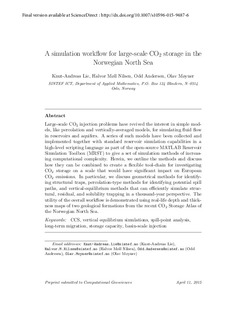A simulation workflow for large-scale CO2 storage in the Norwegian North Sea
Journal article, Peer reviewed
Accepted version
Permanent lenke
http://hdl.handle.net/11250/2473110Utgivelsesdato
2015Metadata
Vis full innførselSamlinger
- Publikasjoner fra CRIStin - SINTEF AS [5801]
- SINTEF Digital [2501]
Sammendrag
Large-scale CO2 injection problems have revived the interest in simple models, like percolation and vertically-averaged models, for simulating fluid flow in reservoirs and aquifers. A series of such models have been collected and implemented together with standard reservoir simulation capabilities in a high-level scripting language as part of the open-source MATLAB Reservoir Simulation Toolbox (MRST) to give a set of simulation methods of increasing computational complexity. Herein, we outline the methods and discuss how they can be combined to create a flexible tool-chain for investigating CO2 storage on a scale that would have significant impact on European CO2 emissions. In particular, we discuss geometrical methods for identifying structural traps, percolation-type methods for identifying potential spill paths, and vertical-equilibrium methods that can efficiently simulate structural, residual, and solubility trapping in a thousand-year perspective. The utility of the overall workflow is demonstrated using real-life depth and thickness maps of two geological formations from the recent CO2 Storage Atlas of the Norwegian North Sea.
